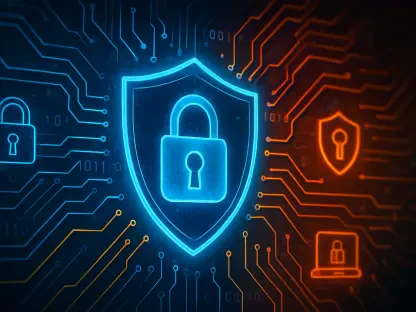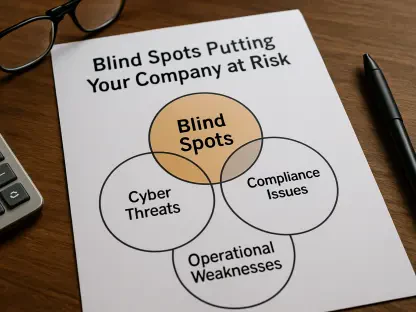The cybersecurity market is on a trajectory of rapid growth, driven by the increasing frequency and sophistication of cyber threats. As digital transformation accelerates across various industries, the need for robust security measures has never been more critical. This article delves into the factors propelling the market’s expansion, emerging trends, and key segments poised for significant growth.
Technological Advancements and Sophisticated Threats
As technology continues to advance at a rapid pace, so too do the threats posed by increasingly sophisticated cybercriminals. The constant evolution of digital tools and platforms has created new vulnerabilities that malicious actors are quick to exploit. This dynamic landscape requires companies and individuals alike to remain vigilant and proactive in their cybersecurity measures to protect sensitive information from ever-evolving threats.
Rising Sophistication of Cyber Threats
Cybercriminals are continually developing more advanced methods to breach security systems. This escalating threat landscape necessitates the adoption of cutting-edge technologies such as artificial intelligence (AI) and machine learning (ML). These advanced technologies enhance threat detection and response capabilities, enabling organizations to stay ahead of cyber adversaries. The evolving nature of cyber threats requires continuous innovation and adaptation to maintain a security infrastructure that can preemptively thwart potential attacks.
Additionally, cybercriminals often target systems using increasingly sophisticated techniques such as phishing, ransomware, and advanced persistent threats (APTs). These attacks are designed to exploit vulnerabilities in the security systems of organizations, often resulting in significant financial and reputational damage. Hence, the adoption of AI and ML has become critical in identifying these threats by analyzing vast amounts of data in real-time. By discerning patterns and anomalies, security systems can quickly detect and respond to potential breaches, thereby mitigating damage and reducing the impact of cyberattacks.
Adoption of AI and ML in Cyber Security
AI and ML are revolutionizing the cybersecurity industry by automating threat detection and response processes. These technologies can analyze vast data sets in real-time, identifying patterns and anomalies that may indicate a cyber attack. As a result, organizations can respond more swiftly and effectively to potential threats, minimizing damage and disruption. Traditional security measures often struggle to keep pace with the sheer volume and variety of threats, making AI and ML indispensable tools in the modern cybersecurity arsenal.
Implementing AI and ML allows organizations to streamline their security operations, reducing the dependency on human intervention. These technologies can also predict future threats by learning from past incidents and continuously updating their algorithms. This proactive approach to cybersecurity ensures that organizations can anticipate and prepare for emerging threats, maintaining a robust defense against cyber adversaries. Moreover, the integration of AI and ML in cybersecurity frameworks enhances overall security resilience, enabling organizations to safeguard their critical assets and data effectively.
Adoption of Cloud-Based Solutions
Shift Towards Cloud-Based Cybersecurity
There is a significant shift towards cloud-based cybersecurity solutions due to their scalability, flexibility, and cost-effectiveness. Cloud-based solutions offer improved security measures that are crucial for protecting sensitive data and ensuring compliance with regulatory standards. This trend is driven by the growing need for secure remote access and data protection in an increasingly digital and interconnected world. The adoption of cloud-based security solutions allows organizations to implement robust security measures without the need for extensive on-premises infrastructure.
The shift towards cloud-based cybersecurity is also fueled by the increasing popularity of Software-as-a-Service (SaaS) applications. These applications require secure data storage and transmission, making cloud-based security solutions essential. Organizations are now leveraging cloud platforms to deploy security measures that can be easily scaled up or down based on their needs. This flexibility is particularly valuable in dynamic business environments where security requirements can change frequently. Consequently, cloud-based security solutions have become a cornerstone of modern cybersecurity strategies.
Benefits of Cloud-Based Security Solutions
Cloud-based security solutions provide several advantages over traditional on-premises systems. They offer scalability, allowing organizations to adjust their security measures as their needs evolve. Additionally, cloud solutions are often more cost-effective, reducing the need for significant upfront investments in hardware and software. The flexibility of cloud-based security also enables organizations to quickly adapt to changing threat landscapes and regulatory requirements. This adaptability ensures that organizations can maintain robust security postures regardless of external developments.
Furthermore, cloud-based security solutions provide enhanced collaboration capabilities, allowing security teams to work more effectively across different locations. These solutions often come with advanced threat intelligence and analytics features that improve the overall security posture of an organization. By leveraging cloud-based platforms, organizations can benefit from continuous updates and improvements from cloud service providers, ensuring that their security measures remain current. Cloud-based security also simplifies the process of integrating security protocols across varying environments, streamlining security management and enhancing overall efficiency.
Impact of Remote Work and IoT
The shift towards remote work has significantly influenced the adoption and development of Internet of Things (IoT) technologies. As more employees work from home, there is an increasing need for connected devices that can facilitate communication, productivity, and security. This trend has spurred innovation in smart home devices, virtual collaboration tools, and cybersecurity measures. The integration of IoT in the remote work environment has also highlighted the importance of robust networks and reliable internet connectivity, prompting advancements in infrastructure and services. As a result, businesses are investing more in IoT solutions to ensure seamless operations and maintain competitive advantage in this evolving landscape.
Surge in Remote Work
The surge in remote work has increased the demand for robust cybersecurity measures. With more employees working remotely, organizations need to ensure secure access to their networks and data. This shift has led to a greater emphasis on securing remote endpoints and implementing comprehensive security solutions to protect against potential threats. Remote work environments introduce unique challenges in safeguarding data, requiring innovative security measures that extend beyond traditional office settings.
Remote work necessitates the implementation of Virtual Private Networks (VPNs), multi-factor authentication (MFA), and secure remote desktop protocols to maintain the integrity of organizational data. Moreover, employees working from home often use personal devices that may not have the same level of security as corporate devices, thereby increasing vulnerability. Therefore, implementing comprehensive cybersecurity policies and providing regular training for remote employees has become crucial in mitigating these risks. Organizations must consistently upgrade their security frameworks to accommodate the evolving nature of remote work.
Proliferation of IoT Devices
The widespread adoption of IoT devices has expanded the attack surface, making it essential to implement comprehensive security solutions. IoT devices, ranging from smart home gadgets to industrial sensors, are often vulnerable to cyber-attacks. As these devices become more integrated into daily operations, securing them becomes a critical priority for organizations. The interconnected nature of IoT ecosystems means that a breach in one device can potentially compromise the entire network, leading to catastrophic consequences.
IoT devices are typically designed for functionality and ease of use, often at the expense of robust security measures. This inherent vulnerability necessitates the development of specialized security protocols tailored to IoT environments. Organizations must conduct regular risk assessments, implement encryption standards, and ensure that IoT devices receive timely software updates. By adopting a proactive approach to securing IoT devices, organizations can protect their critical infrastructure and sensitive data from cyber threats. This proactive approach is essential as IoT devices continue to proliferate across various sectors, making cybersecurity an integral aspect of IoT deployment.
Regulatory Compliance
The SEC’s cautious approach and call for public comment aim to ensure that the complexities of cryptocurrencies are thoroughly addressed. Through extensions and public insight, they strive to integrate digital assets into regulatory frameworks attentively. This mirrors the delays faced by Grayscale in its efforts to transform its Ethereum Trust into a spot ETF, highlighting differences in regulatory processes for Bitcoin and Ethereum.
Stringent Regulatory Requirements
Stringent regulatory requirements are driving the adoption of advanced cybersecurity measures. Governments and regulatory bodies worldwide are imposing strict data protection and privacy regulations, compelling organizations to invest in cybersecurity to avoid heavy penalties and reputational damage. Compliance with standards such as GDPR (General Data Protection Regulation) and CCPA (California Consumer Privacy Act) is paramount for businesses operating in regulated industries. These regulations mandate the implementation of rigorous security protocols to safeguard sensitive data and ensure privacy.
Organizations that fail to comply with these regulations face severe consequences, including financial fines and loss of customer trust. Therefore, adhering to regulatory requirements has become a top priority for businesses. To meet these standards, organizations are implementing advanced security measures, conducting regular audits, and continuously updating their security frameworks. This compliance-driven approach not only helps in avoiding legal repercussions but also enhances the overall security posture of an organization, fostering greater trust among clients and stakeholders.
Importance of Compliance
Compliance with regulatory standards is not just about avoiding penalties; it also builds trust with customers and stakeholders. Organizations that prioritize data protection and privacy are more likely to gain the confidence of their clients, leading to stronger business relationships and a competitive edge in the market. Demonstrating a commitment to compliance reinforces the organization’s reputation as a responsible entity that values the security of its customers’ information.
Moreover, regulatory compliance fosters a culture of security awareness within the organization. Employees become more vigilant and proactive in safeguarding data, reducing the likelihood of breaches. By embedding security practices into their operational framework, organizations can effectively navigate the complex regulatory landscape. This strategic approach to compliance not only ensures adherence to legal standards but also enhances the resilience of the organization against evolving cyber threats. Ultimately, regulatory compliance serves as a catalyst for improving the overall security posture and operational efficiency of businesses.
Shortage of Skilled Professionals and High Costs
Talent Gap in Cyber Security
Despite the robust growth of the cyber security market, challenges such as the shortage of skilled cybersecurity professionals constrain market expansion. The industry faces a significant talent gap, with the demand for skilled professionals outstripping supply. This shortage makes it difficult for organizations to find and retain the expertise needed to effectively manage their cybersecurity infrastructure. The talent gap poses a significant risk, as organizations may struggle to maintain adequate security measures without sufficiently trained personnel.
Addressing the talent gap requires a multifaceted approach, including investing in education and training programs to cultivate new talent. Collaborations between academia, industry, and government agencies can help bridge the skills gap by developing specialized cybersecurity curricula and providing hands-on training opportunities. Additionally, organizations can invest in upskilling their current workforce and adopting automation tools to alleviate some of the burdens due to the talent shortage. By prioritizing the development of a skilled cybersecurity workforce, the industry can better equip itself to handle the increasing complexity of cyber threats.
High Costs of Advanced Security Solutions
The high costs associated with implementing advanced security solutions can be prohibitive for small and medium-sized enterprises (SMEs). The initial investment and ongoing maintenance costs for sophisticated cybersecurity solutions can strain the budgets of smaller organizations. However, the increasing availability of cost-effective cloud-based solutions and managed security services is helping to mitigate this challenge. SMEs can now access state-of-the-art security measures without the need for extensive capital expenditure.
Managed security service providers (MSSPs) offer a viable alternative for SMEs looking to bolster their cybersecurity posture without incurring substantial costs. These providers offer scalable and customizable security solutions, ensuring that organizations of all sizes can implement robust security measures. By outsourcing cybersecurity to MSSPs, SMEs can leverage expert knowledge and resources, enabling them to focus on their core business operations. This approach allows smaller organizations to stay competitive in a landscape where cyber threats are becoming increasingly sophisticated.
Managed Security Services and Emerging Technologies
Investment in Managed Security Services
Organizations are increasingly investing in managed security services to bolster their cybersecurity posture. Managed security service providers (MSSPs) offer ongoing support, monitoring, and management of security solutions, allowing organizations to focus on their core business operations. This approach provides access to expert knowledge and resources that may be otherwise unavailable in-house. By outsourcing their cybersecurity needs, organizations can ensure continuous protection and rapid response to potential threats.
MSSPs offer a range of services including threat detection, incident response, and compliance management. These services are tailored to meet the specific needs of each organization, ensuring a customized approach to cybersecurity. Additionally, MSSPs leverage advanced technologies and industry best practices to enhance their service offerings. This partnership allows organizations to remain agile and responsive in a constantly evolving threat landscape. By investing in managed security services, organizations can achieve a higher level of security resilience and operational efficiency.
Leveraging Emerging Technologies
Emerging technologies such as AI, ML, and blockchain are being leveraged to enhance threat detection, automate response processes, and improve overall security resilience. These technologies offer innovative solutions to complex cybersecurity challenges, enabling organizations to stay ahead of evolving threats and protect their critical assets. AI and ML, for instance, can process vast datasets to identify unusual patterns and potential threats, facilitating faster and more accurate response mechanisms.
Blockchain technology, known for its secure and immutable nature, is being utilized to safeguard data integrity and ensure secure transactions. By leveraging blockchain, organizations can create tamper-proof records and enhance transparency in their operations. Additionally, technologies like quantum computing are emerging as potential game-changers in cybersecurity, offering unprecedented computational power to solve complex security challenges. Embracing these emerging technologies allows organizations to strengthen their cybersecurity frameworks, ensuring robust protection against advanced cyber threats.
Market Segmentation
Offering: Solutions and Services
The cybersecurity market is divided into solutions and services. The solution segment includes network security, application security, endpoint security, infrastructure security, and others. The service segment comprises professional services and managed services. In 2023, the solution segment held the highest market share due to the increasing demand for comprehensive security solutions. Organizations are prioritizing robust cybersecurity measures to protect sensitive data and ensure regulatory compliance, driving the growth of this segment.
Conversely, the services segment is expected to register the highest CAGR during the forecast period, propelled by the need for ongoing support and management of cybersecurity infrastructure. As organizations face evolving threats, they require expert services for incident response, risk assessment, and compliance management. This demand for continuous support services reflects the dynamic nature of the cybersecurity landscape, where threats are constantly evolving, and preparedness is paramount. The rise of MSSPs and other service-oriented solutions is a testament to the growing reliance on specialized expertise in cybersecurity management.
Deployment: On-Premises and Cloud
Deployment modes in the cybersecurity market are categorized into on-premises and cloud. The cloud segment dominated the market in 2023 and is anticipated to grow at the highest CAGR due to the benefits of scalability, cost-effectiveness, and flexibility offered by cloud-based security solutions. The shift towards remote work and the need for secure cloud services further drive the adoption of cloud-based cybersecurity measures. Cloud-based solutions provide organizations with the agility to respond to changing security needs without significant infrastructure investment.
On-premises solutions, while still relevant, are often associated with higher costs and less flexibility compared to their cloud-based counterparts. However, certain industries with stringent data privacy requirements or legacy systems may continue to rely on on-premises deployments. Despite this, the overall trend is moving towards cloud-based solutions due to their adaptability in meeting modern security challenges. The cloud’s ability to offer real-time updates, reduced maintenance costs, and enhanced collaboration capabilities makes it an attractive option for organizations looking to modernize their cybersecurity infrastructure.
Industry Vertical: BFSI, Healthcare, and Others
The cybersecurity market is further segmented into various industry verticals, including BFSI (Banking, Financial Services, and Insurance), healthcare, government and defense, IT and telecom, retail, and others. The BFSI segment held the largest share in 2023 due to the high value of financial data and the stringent regulatory requirements in the sector. Financial institutions are prime targets for cybercriminals, necessitating robust security measures to protect sensitive financial information and maintain customer trust.
However, the healthcare segment is expected to register the highest CAGR during the forecast period owing to the increasing need to protect sensitive patient data and comply with healthcare regulations. With the advent of digital health records and telemedicine, the healthcare industry has become a significant target for cyber attacks. Consequently, healthcare organizations are investing heavily in advanced security solutions to safeguard patient data and ensure compliance with regulations such as HIPAA (Health Insurance Portability and Accountability Act). Other industry verticals such as government and defense, and IT and telecom are also prioritizing cybersecurity due to the critical nature of the data they handle.
Enterprise Size: Large Enterprises and SMEs
Based on enterprise size, the cybersecurity market is categorized into large enterprises and small and medium-sized enterprises (SMEs). In 2023, large enterprises dominated the market share due to their substantial cybersecurity budgets and higher risk of cyber threats. These organizations are more likely to be targeted by sophisticated cyberattacks, prompting them to allocate considerable resources to their cybersecurity infrastructure. Large enterprises often have dedicated security teams and extensive security protocols in place to protect their data and operations.
However, the SME segment is expected to grow at a significant rate as these enterprises increasingly recognize the importance of cybersecurity and invest in protective measures. SMEs are often seen as easier targets for cybercriminals due to their relatively weaker security postures. As awareness of cyber threats grows, SMEs are investing in cost-effective security solutions and managed security services to protect their operations. This increased focus on cybersecurity among SMEs is driving market growth and ensuring that these businesses can operate safely in an increasingly digital landscape.
Region: North America, Europe, and Asia-Pacific
The cybersecurity market is experiencing rapid growth, fueled by the rising frequency and complexity of cyber threats. With the digital transformation sweeping across various sectors, the need for robust and reliable security measures has become increasingly crucial. This surge in demand is driven by several factors, including the proliferation of connected devices, the advent of cloud computing, and the growing reliance on remote work. These changes have made industries more vulnerable to attacks, highlighting the importance of advanced cyber defenses.
Emerging trends in the market include the increasing use of artificial intelligence and machine learning to detect and respond to threats in real-time. The adoption of Zero Trust architectures, which verify each access attempt as though it originates from an open network, is also on the rise. Key segments poised for significant growth are identity and access management, endpoint security, and network security. This article explores the market’s expansion drivers, noteworthy trends, and the parts likely to see substantial growth in the near future, emphasizing the critical need for enhanced cybersecurity solutions.









